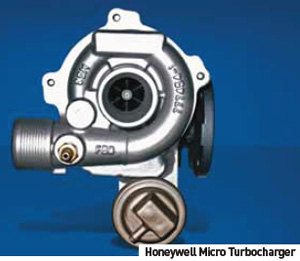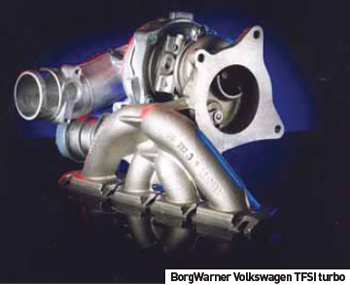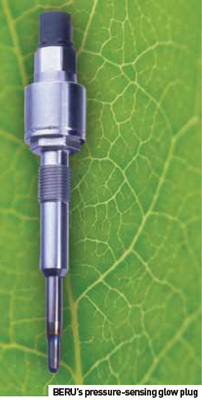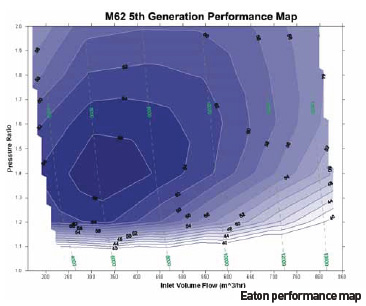Engineers are using technology rather than displacement to achieve required levels of engine performance, and the changing designs have affected unit production
So is there no substitute for cubic inches? With their long-time dedication to large V8 engines, American drivers might say so. Even in Europe and Asia, despite the economic climate, the number of 50cc mopeds is down and models with V6 and V8 engines are plentiful. Consumer demand and passive safety improvements have resulted in larger, heavier and ever more complex vehicles, yet it is the pleasure of effortless power that comes with large capacity engines that has perhaps ensured they maintain driver loyalty.
For carmakers though, fuel efficiency targets and emissions regulations have effectively curtailed large engine production, replaced by the challenge of meeting customer expectations on drivability and performance while minimizing fuel consumption and emissions. To achieve these goals, companies have turned to diesel powerplants fitted with increasingly sophisticated forced induction technologies. The natural affinity of diesel engines to turbo technologies – providing benefits in performance, responsiveness, fuel consumption and emissions reduction – has been augmented by new turbo developments where sequential, and more recently parallel, dual-stage turbo systems, such as that developed for PSA Peugeot Citroen by Honeywell, have transformed the latest generation of diesel offerings. Such advances have seen the adoption of the engines in areas of the market previously resistant to the pairing.
As for petrol engines, an even wider range of options is available, with both turbos and superchargers being explored, together with direct injection and increasingly sophisticated variable valve timing control systems. Even those manufacturers traditionally cautious about forced induction have recently moved in that direction.
Mercedes, for example, although manufacturers of the first production turbodiesel in 1978, remained low volume producers of turbocharged models until recent fuel efficiency and emissions regulations brought about the need to re-evaluate engine design, with future model ranges offering a selection of turbo diesel models. Thomas Weber, Daimler Benz board member in charge of research and product comments, “All of our vehicles will have turbocharged engines in series production by the end of 2010 at the latest.”
Similarly, Jaguar has increasingly moved towards forced induction power plants, with blown versions of the 5.0 litre V8 and a heavily revised bi-turbo 2.7 litre diesel, together with development of a new, forced induction 3.0 litre straight-six version. Audi has rekindled interest in supercharging, despite being one of the original turbo pioneers, with the new supercharged TFSI V6 engine combining a supercharger with direct injection technology.
Using an Eaton Roots-type supercharger, with two counter rotating, four-vane rotors feeding through to a front intercooler, it boosts up to 0.8 bar.
The installation exemplifies the designer’s desire for short gas paths after the compressor, benefitting response and low-speed torque, while the small size of the supercharger allows it to nestle between the cylinder banks. As with many other manufacturers, Audi emphasizes the desirability of exceptional torque from low engine speeds to give their vehicles the feeling of smooth performance demanded by customers. Speaking about the use of a supercharger over a turbo, Audi’s Michael Fitzen comments that the decision was motivated by ‘…the available power at lower revs compared with a turbo’.
Alongside lean burn, direct injection and cylinder deactivation technologies, sophisticated forced induction designs are now used by manufacturers across the globe to improve economy and emissions performance in away that will also produce an enhanced driving experience and generate a positive customer experience.
Growth potential remains positive
 Turbo suppliers are reporting significantly increased interest in their products in the US, where several factors serve to focus the attention of manufacturers on the potential of forced induction. Following the recent spike in fuel prices, US motorists have been exploring the idea of smaller engines and diesel options with increasing interest. As Craig Balis, Vice-President for Product Development at Honeywell Turbos puts it; “The US is now a ripe environment for us.”
Turbo suppliers are reporting significantly increased interest in their products in the US, where several factors serve to focus the attention of manufacturers on the potential of forced induction. Following the recent spike in fuel prices, US motorists have been exploring the idea of smaller engines and diesel options with increasing interest. As Craig Balis, Vice-President for Product Development at Honeywell Turbos puts it; “The US is now a ripe environment for us.”
If proof were needed, Honeywell points to the large number of upcoming vehicle launches featuring the company’s turbo technologies, with the traditionally petrol-based US passenger car market showing increased adoption of diesel power plants invariably fitted with a turbo. Estimates place the market growth level at between 15 to 20% over the next few years and with Honeywell’s 2008 turbo production running in excess of 8 million units, the company remains confident despite the current downturn.
Yet growth is also expected in developing markets.
Analysts suggest China may top the list with current annual turbo sales estimated at over 8m units, while projections made in happier economic times pointed to a 20% yearon- year growth rate. Although this is now unlikely, the rate of growth will still be enviable. Balis is confident that turbo charging will play a key role in future vehicle developments and that Honeywell is well placed to benefit from any market growth. “Our turbo developments span such a wide range, from new micro turbos, designed for vehicles with as little as 0.6 litre engine capacity, to systems for vehicles of four or more litres.”
Each system is tailored and reconfigured to match the precise needs of the vehicle manufacturer, explains Balis, with Honeywell offering “conventional waste gate turbos, through variable geometry systems, and extending up to much more complex multi-stage and twin-compressor units.” Marketed under the Garrett brand, Balis is quick to point out that the company has the capability and resources necessary to meet the engineering and commercial challenges of the future.
Part of this heritage is a culture of innovation that has lead to significant advances in turbine aerodynamics, the application of appropriate high temperature materials, together with sophisticated thermo analysis and balancing technologies. Part of the challenge is that turbos are, as has often been pointed out, an aero technology, but produced on a mass scale. Future developments in system architecture will be matched on the part of all suppliers by continued emphasis on new materials and manufacturing processes.
So-called foil bearings are one such possible future technology. With the turbo shaft supported on a compliant spring-loaded foil journal, the air pressure developed at high speeds separates the bearing and journal, providing an alternative to more traditional bearing types. Use of such bearings, albeit most suitable (at the moment) for low load applications, obviates the need for pressurized oil systems or water cooling, as well as the potential of enhanced longevity. By minimizing friction in this way, turbo lag can be reduced and turbo performance can be greatly improved. With turbo impellers frequently working in excess of 250,000 rpm, bearing tolerances, balancing and manufacturing issues are crucial. Interestingly, the major players in the market all have long histories, with almost all tracing involvement back to the beginning of the application technologies.
 Honeywell provides twin-scroll solutions for petrol engines, but is now actively encouraging the application of increasingly sophisticated variable geometry turbine technologies in this sector. Their VNT and AVNT models deliver a reduced engine outlet pressure for a given boost level, resulting in higher performance. The throat section at the turbo intake is adjusted in line with the optimum gas flow at a particular engine speed. Adjustment is effected by either electronic control via a vacuum actuator or pressure actuator. In other models, a mobile multivane system is used where the vanes are rotated relative to the turbine wheel axis to modify the flow characteristics of the turbo. At low engine speeds, Garrett VNT and AVNT turbos produce higher and more responsive boost levels with the lower engine outlet pressures reducing pumping losses. In commercial vehicle applications the abilities of the AVNT to integrate with exhaust gas recirculation (EGR) systems assists engineers in meeting new commercial vehicle emission requirements.
Honeywell provides twin-scroll solutions for petrol engines, but is now actively encouraging the application of increasingly sophisticated variable geometry turbine technologies in this sector. Their VNT and AVNT models deliver a reduced engine outlet pressure for a given boost level, resulting in higher performance. The throat section at the turbo intake is adjusted in line with the optimum gas flow at a particular engine speed. Adjustment is effected by either electronic control via a vacuum actuator or pressure actuator. In other models, a mobile multivane system is used where the vanes are rotated relative to the turbine wheel axis to modify the flow characteristics of the turbo. At low engine speeds, Garrett VNT and AVNT turbos produce higher and more responsive boost levels with the lower engine outlet pressures reducing pumping losses. In commercial vehicle applications the abilities of the AVNT to integrate with exhaust gas recirculation (EGR) systems assists engineers in meeting new commercial vehicle emission requirements.
Ford has chosen Honeywell solutions for the turbo systems in its new EcoBoost range of engines, the pairing demonstrating the levels of performance gain available with modern, carefully engineered turbo systems. Wide torque bands and seamless power delivery combined with improved fuel consumption and adherence to rigorous emission limits are the often conflicting requirements that suppliers have to address. The solution used in the V6 3.5 litre EcoBoost engine will return torque of above 340ft/lbs (541Nm) across the 2000-5000 rpm band.
At the other end of the scale, IHI has devoted recent efforts to further promoting the use of turbo charging on smaller capacity vehicles, expanding the use of such equipment by companies such as Daihatsu that has offered turbos on engines under one-litre capacity using IHI equipment. Recently, IHI announced the development of what has been described as the world’s smallest turbos. In adding a turbo to smaller-capacity engines, Honeywell’s Craig Balis points out that it is not necessarily a simple scaling down exercise. “The exhaust gas pulses from small capacity power units can be quite distinctive and can present a whole new set of engineering challenges.”
Complex technologies to achieve complex goals
Modern turbo technology has become much more elaborate.
 In the US, for example, BorgWarner has introduced regulated, two-stage turbocharging (complete with variable turbine geometry), alongside sophisticated exhaust gas recirculation systems for the heavy-duty pickup sector; the area expected to see increased adoption of diesel power units. The heavy-duty diesel engines installed in recent Ford F-Series pickups, developed by International Engine Group, feature twin turbos of various sizes, located in the centre of the cylinder Vee, with the smaller turbo featuring variable turbine geometry (VTG) to help the engine meet the most stringent of emissions and performance targets. VTG guide vanes in this application are adjusted electronically using an electric actuator motor.
In the US, for example, BorgWarner has introduced regulated, two-stage turbocharging (complete with variable turbine geometry), alongside sophisticated exhaust gas recirculation systems for the heavy-duty pickup sector; the area expected to see increased adoption of diesel power units. The heavy-duty diesel engines installed in recent Ford F-Series pickups, developed by International Engine Group, feature twin turbos of various sizes, located in the centre of the cylinder Vee, with the smaller turbo featuring variable turbine geometry (VTG) to help the engine meet the most stringent of emissions and performance targets. VTG guide vanes in this application are adjusted electronically using an electric actuator motor.
It is of paramount importance to approach turbo or supercharger installation as an integrated part of the whole engine development process. Increasingly, EGR technologies have a crucial impact on turbo system design, with advances in recirculation controls impacting on the potential of forced induction systems. BorgWarner, for example, points to the need to maintain precise EGR control alongside high recirculation rates. Commenting on the introduction of the company’s new electric butterfly EGR valve, a BorgWarner executive recently pointed out that ‘new engine concepts for commercial vehicles require greater use of state-of-the-art EGR systems’, further commenting that there is ‘a growing demand in this market segment’.
In the passenger car sector, BorgWarner points to its success with the Volkswagen TDi engine installed in the US-market VW Jetta that meets Tier 2 BIN5 emission standards. The turbocharger on the EU5 basic engine was optimized for use with low-pressure exhaust gas recirculation. To compensate for high thermal loads generated by the recirculation process, the company developed special nano coatings for the compressor components, together with a new milled compressor wheel within the VTG turbo, the low-pressure gas recirculation helping to minimize nitrogen oxide emissions. Exhaust gas is tapped downstream of the particulate filter and reintroduced upstream of the turbo. Until recently, this process had been unworkable due to the high temperatures generated and the acidic character of the gases produced by the turbo compressor.
Turbocharger cases are subject to massive thermal loads, while compressor wheels must combine low inertia with complex shape and mechanical strength.
Direct injection components operate at very high pressure and demand close tolerances. The speed, pressure and temperatures of the intake charge is determined in part by a turbocharger’s internal aerodynamic character. The spiral-shaped volutes build pressure via their precise tapered shape. Any surface inconsistencies or defects in the complex three-dimensional geometry of the volutes may at best generate turbulence that will impair efficiency or at worse lead to premature failure.
CAD & CAM systems have developed dramatically in recent years and this has had a beneficial impact on the time taken for new designs to reach production, as well as the ease with which changes can be made. Delcam, for example, point to their work with Cummins and its turbo supplier Holset, where greatly improved casting quality has been achieved in truck turbos by use of new CAD/CAM technologies, allowing the turbo design to be imported directly into a pattern shops’ CAD system. In this way, the geometry manipulations necessary to optimise the associated tool and pattern making processes for manufacture can be streamlined.
Doncaster Trucast has been producing ‘hot end’ turbine wheels for over forty years and its Trucast process was designed specifi cally for this category of product, involving the latest in wax pattern manufacturing and casting technologies. Doncaster list among its customers well-known turbocharger OEMs including Honeywell, BorgWarner, IHI and Holset. Much of the production process is highly automated, with automated injection tooling, an automated shell line and a unique, automated vacuum casting processes.
Other manufacturers, such as Turbocam, have also relied on high levels of automation to ensure they can meet the demanding cost and quality requirements of the auto industry. Turbocam produces turbo impellers machined from solid 2618 aluminum, rather than via a casting and machining process. Investment in highly sophisticated five axis machining centres and appropriate control systems have allowed dramatic per-unit cost reductions, offering manufacturers much sought after quality improvement. Using Chiron high-speed machining centres, Turbocam was able to develop a 24/7, fully-automated production capability.
This has required taking advantage of machines capable of the very high speed accelerations and decelerations needed for the fast, continuous machining of complex impeller shapes involving constantly shifting cutting paths along all machine axes. Using transformation orientation features incorporated in CNC machinery, based on work piece orientations rather than tool position, high levels of accuracy are achieved, together with the consistent fi nish demanded by customers.
Engine management and monitoring capabilities
Crucial to forced induction performance is accurate monitoring of all combustion and operating parameters.
Long gone are the early days of turbo applications where a crude knock sensor and a degree of fueling response was all that accompanied an other wise largely uncontrolled turbo.
Volkswagen’s TFSI turbo engine operates lean burn and direct injection technology to conserve fuel under low load conditions. With direct injection comes a degree of charge cooling, allowing a higher compression ratio and boost pressure than would be reliably tolerated by a port-injected unit.
On the other hand, Saab’s Trionic 7 system monitors the on-going combustion process by using the spark plugs to measure cylinder pressure via the ionization voltage over the spark plug gaps. In diesel applications, BERU has developed a similar monitoring effect using the engine glow plugs as a cylinder monitor, feeding information back to the ECU.
Increasingly complex linkages between turbo systems and drivetrain, including cylinder deactivation controls, are now appearing on production vehicles and will undoubtedly undergo further development. Ford of Australia uses what it terms ‘adaptive variable camshaft timing’ to improve turbo response, with alternative camshaft timing modes used for different driving patterns. On manual transmission versions of the 4.0 litre 16Turbo series vehicles, Ford now offers a form of programmed launch control which, when the vehicle is stationary and the clutch disengaged, cuts fuel via the electronic throttle to deactivate cylinders, which then pump air to spool the turbos, effectively priming the system in anticipation of clutch reengagement.
Increased emissions on cold start and turbo lag are two reasons for the renewed popularity of supercharging.
Used primarily in conjunction with petrol engines, the attraction of improved low speed response has served to further encourage investigation of engine boosting via the crankshaft.
 Eaton, as one of the major players in the supercharger market, has partnered with VW to produce a combination supercharger-turbocharger system (available on Golf GTi models), with the belt-driven supercharger providing induction pressure at low rpm and the turbocharger dealing with the higher volume needs at increased engine speeds.
Eaton, as one of the major players in the supercharger market, has partnered with VW to produce a combination supercharger-turbocharger system (available on Golf GTi models), with the belt-driven supercharger providing induction pressure at low rpm and the turbocharger dealing with the higher volume needs at increased engine speeds.
This aside, perhaps the most interesting development in supercharging is the next generation of variable speed supercharger, using a CVT-type gearbox attached to the supercharger. This allows the unit to deliver peak performance only when required, through a system that determines the internal compressor-specific speed.
Transmission specialist Antonov has shown the potential of a new drive system which uses a combination of centrifugal force and axial trusts applied to helical gears under load to produce a self-shifting mechanical system for powering engine-driven ancillaries. Further, it is developing applications for supercharger drives where it offers a simple solution to the problem of developing and maintaining adequate boost levels at low engine speeds. A novel two speed supercharger, incorporating the Antonov drive module, is now available as an aftermarket accessory for various vehicles, while the company hopes it will be adopted as standard equipment. The after market kit for the Hummer H3 – now offered as a dealer fit option in France – shows the benefits of this technology, offering a welcome increase in torque at low revs alongside the standard improvement in top end performance usually associated with supercharged engines.
The Gen V supercharger is Eaton’s latest evolution of the venerable Roots design. It features two, three-lobe rotors, twisted 60 degrees. The Twin Vortices Series (TVS) features twin four-lobe rotors combined with a much more acute 160 degree twist which, Eaton claims, can enhance air flow into the engine when combined with newly-redesigned ports.
The unit is also said to achieve improved noise and vibration characteristics. It is a case where centrifugal superchargers have lost ground to positive displacement designs simply because they fail to build boost at low rpm.
As induction systems have become more complex, packaging issues have also become increasingly problematic. Multistage turbocharging can involve significant duplication of pipe work and waste gate hardware. Allied to this, the heat build up generated in turbos and the complex routing of pipe work for EGR recirculation and to charge coolers - all in heat-sensitive environments - represents a significant challenge to designers. Engine-driven supercharging can offer a less problematic installation route, as heat build-ups are less extreme and pipe work can be more simple in layout, though the drive system imposes its own constraints.
Honeywell’s Craig Balis explains that much of the company’s design and engineering centres on assisting manufacturers with packaging issues. “Even where the same engine is used in different applications, we will have to develop a whole range of different components, each with different part numbers, to suit the specific installation.”
The future of forced induction
Turbocharging and supercharging look set to retain a role in many of the alternative engine developments now capturing attention. Hydrogen-fueled internal combustion engines equipped with port fuel injection offer a cheap alternative to fuel cells, and can run in duel-fuel mode to circumnavigate the lack of a widespread hydrogen fuel availability. As a consequence, these technologies are attracting interest among worldwide manufacturers.
Yet hydrogen engines with external mixture formation suffer from the lower volumetric energy density of the externally-formed hydrogen/air mixture and are prone to abnormal combustion patterns and backfire. A recent SAE research paper pointed to the benefits of supercharging such engines in conjunction with exhaust gas recirculation.
Not only does this increase engine power levels, but it also limits emissions of nitrogen oxides. By varying supercharger pressures and EGR rates, throttle-less operation is possible, with the associated benefits in overall engine efficiencies.
Eaton has recently addressed combining supercharging with hybrids, pointing to the improved drivability in standard hybrids and the suitability of the variable speed units in extending range and maximizing low-end power for plug-in hybrids. The potential of electrically-driven superchargers is also being explored, primarily in relation to fuel cell technologies rather than more conventional power units. Research, funded in part by the Engineering and Physical Sciences Research Council, on Homogenous Charge Compression Ignition (HCCI) technologies has explored the effect of charge boosting to extend the operating window of such engines, as well as exploring the potential of exhaust gas fuel-reforming processes. Elsewhere, extended research has established a role for supercharging in controlling nitrogen oxide emissions in a variety of future power units. Turbocharging has recently celebrated its fiftieth birthday, while supercharging has an even longer heritage, yet both technologies are attracting more attention than ever and look set to play an important role in future engine developments.






































